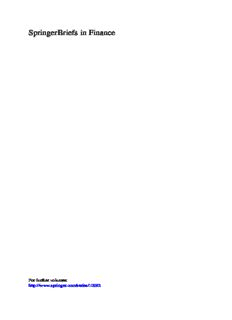
Finance for Academics: A Guide to Investment for Income PDF
Preview Finance for Academics: A Guide to Investment for Income
SpringerBriefs in Finance Forfurthervolumes: http://www.springer.com/series/10282 Ronald A. Francisco Finance for Academics A Guide to Investment for Income 123 RonaldA.Francisco DepartmentofPoliticalScience UniversityofKansas Lawrence,KS, USA ISSN2193-1720 e-ISSN2193-1739 ISBN978-1-4614-3243-2 e-ISBN978-1-4614-3244-9 DOI10.1007/978-1-4614-3244-9 SpringerNewYorkDordrechtHeidelbergLondon LibraryofCongressControlNumber:2012933790 ©RonaldA.Francisco2012 Allrightsreserved.Thisworkmaynotbetranslatedorcopiedinwholeorinpartwithoutthewritten permission of the publisher (Springer Science+Business Media, LLC, 233 Spring Street, New York, NY10013, USA),except forbrief excerpts inconnection with reviews orscholarly analysis. Usein connectionwithanyformofinformationstorageandretrieval,electronicadaptation,computersoftware, orbysimilarordissimilarmethodologynowknownorhereafterdevelopedisforbidden. Theuseinthispublicationoftradenames,trademarks,servicemarks,andsimilarterms,eveniftheyare notidentifiedassuch,isnottobetakenasanexpressionofopinionastowhetherornottheyaresubject toproprietaryrights. Printedonacid-freepaper SpringerispartofSpringerScience+BusinessMedia(www.springer.com) ForBenjamin Preface I first learned about finance in 1975 when Professor Allan J. Cigler told me to buy utility stocks because for the next 2 years their dividends would be tax free. I did, and am forever thankful to him for getting me interested in finance and investment.Professor Cigler played another large role about 8 yearsago when he cametomyofficeandtoldmethatourassistantprofessorsthoughttheywouldbe getting a pension from the university. “Oh, dear” said I, “what shall we do?” He suggested writing somethingthat would correctthe assistant professors’views on retirementfinance.Iaskedwhetherhewantedto doitorifhewantedmetowrite thisdocument.Hewasbusyatthetime,soIstartedwritingFinanceforAcademics and distributing it to my colleagues. It was not long beforethe documentgrew in size and more academicssoughtit. These were academicsfrom all over,not only frommyuniversity,butfrommanyothersaswell. Over the years Finance for Academics began to spread beyond the academic community.I foundoutthisyear thatit surfacedin Floridain an investmentclass runbyaneconomistfromtheInternationalMonetaryFund.FinanceforAcademics was the text for this class. That alarmed me. I decided then that I would put the documentonmywebsiteandthoughtperhapsI shouldexpandittoprovidebetter andmorethoroughexplanations.Theresultisthisbook. I have tried to render the arcane world of finance somewhat simpler to a sophisticatedaudience.Financeandinvestmenthavegrownevermorecomplicated with new sorts of investments and derivatives of old ones. Some of the most successful investorsare mathematicianswho can understand more easily the high level of mathematics that is today applied to investments. I have attempted to tone down the mathematics, but still show how some of the more important formulaework. TIAA–CREF is the principal retirement entity for most of us. I am somewhat hard on TIAA–CREF in several chapters, in part because the institution is more opaquethanitneedstobeandbecauseperformancesometimessuffer.Nonetheless, vii viii Preface weareluckytohaveTIAA–CREFasa retirementincomesource.We justhaveto dealwithitmorecarefullytoprotectourinterests. I am grateful to my wife Deborah for putting up with this interest for many decadesandtoourson,Christopher,amathematician,whohashelpedbyexplaining themathematicsbehindmanyafinancialequationorformulatome. Lawrence,KS,USA RonaldA.Francisco Contents 1 Introduction .................................................................. 1 1.1 TheOrganizationoftheBook......................................... 2 1.1.1 Risks.......................................................... 2 1.1.2 FormsofInvestments........................................ 3 1.1.3 Dividend-GrowthStocks .................................... 3 1.1.4 BondsandBondFunds...................................... 3 1.1.5 MasterLimitedPartnerships................................. 4 1.1.6 BuildYourOwnPortfolio................................... 4 1.1.7 RetirementIncome........................................... 4 1.1.8 WhatCanGoWrong?TroubleshootingInvestments ...... 4 1.2 Principles............................................................... 5 1.2.1 MaximizeIncome............................................ 5 1.2.2 MinimizeFees................................................ 5 1.2.3 LegallyMinimizeTaxes..................................... 5 1.2.4 ReinvestDividends .......................................... 5 1.3 HowDoIStart?........................................................ 6 1.4 Let’sBegin............................................................. 6 2 Risks........................................................................... 7 2.1 EconomicRisk......................................................... 7 2.2 MarketRisk............................................................ 8 2.3 Inflation ................................................................ 9 2.4 Corruption.............................................................. 10 2.5 HighFees .............................................................. 10 2.6 TheNextNewThing .................................................. 11 2.7 CurrencyRisk.......................................................... 11 2.8 Lethargy................................................................ 12 3 FormsofInvestment......................................................... 13 3.1 Stocks .................................................................. 13 3.1.1 DirectStockPurchase ....................................... 14 3.1.2 AvoidPennyStocks.......................................... 14 ix x Contents 3.1.3 StockPurchasewithaBrokerage ........................... 14 3.1.4 EquityMutualFunds,IndexandExchange- TradedEquityFunds......................................... 15 3.1.5 Closed-EndEquityFundsandPreferredStock............. 16 3.1.6 TheEfficientMarketTheory ................................ 16 3.1.7 ValueBeatsGrowth.......................................... 17 3.2 BondsandBondFunds................................................ 17 3.2.1 IndividualBondsorBondFunds?........................... 17 3.2.2 FormsofBondsandBondFunds ........................... 18 3.3 Options................................................................. 18 3.4 ShortingStocks........................................................ 19 3.5 MasterLimitedPartnerships.......................................... 20 3.6 RealEstateandRealEstateInvestmentTrusts....................... 20 3.6.1 RealEstateInvestmentTrusts............................... 20 3.6.2 RealEstate.................................................... 21 3.7 DerivativeInvestments:BuyerBeware............................... 21 3.8 Annuities............................................................... 21 3.9 Commodities........................................................... 22 3.10 StocksandBondsRedux.............................................. 23 4 Dividend-GrowthStocks.................................................... 25 4.1 InflationasaPersistentProblem...................................... 25 4.2 Dividend-GrowthStocksasaSolution............................... 26 4.3 TheWonderofCompounding ........................................ 27 4.3.1 CompoundingExamples..................................... 27 4.3.2 TheGordonEquation........................................ 28 4.4 Dividend-GrowthStocksandExchange-TradedFunds.............. 29 4.5 TheFloatandTreasuryShares........................................ 30 4.6 ThePowerofCompounding.......................................... 32 4.7 WhytheBother?WhatAboutMutualFunds?....................... 35 4.7.1 WhichMutualFund?AtWhatCost? ....................... 35 4.7.2 FindingDividend-GrowthStocks........................... 36 4.7.3 TheIncomeAdvantage...................................... 36 4.8 SectorDiversification.................................................. 37 4.8.1 Banks......................................................... 37 4.8.2 ConsumerProducts .......................................... 37 4.8.3 Energy........................................................ 38 4.8.4 FoodandRestaurants........................................ 38 4.8.5 Manufacturing................................................ 38 4.8.6 Rails .......................................................... 38 4.8.7 Retail ......................................................... 38 4.8.8 Services....................................................... 39 4.8.9 Technology................................................... 39 4.8.10 Utilities....................................................... 39 4.9 StockSplits ............................................................ 39
Description: